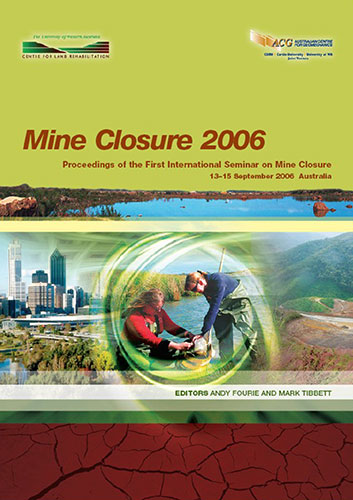Understanding Waste Rock Dump Hydrology is Essential for Effective Closure Planning and ARD Management

|
Authors: Wright, A |
DOI https://doi.org/10.36487/ACG_repo/605_34
Cite As:
Wright, A 2006, 'Understanding Waste Rock Dump Hydrology is Essential for Effective Closure Planning and ARD Management', in AB Fourie & M Tibbett (eds), Mine Closure 2006: Proceedings of the First International Seminar on Mine Closure, Australian Centre for Geomechanics, Perth, pp. 417-426, https://doi.org/10.36487/ACG_repo/605_34
Abstract:
The creation of large unsightly waste rock dumps is synonymous with mining in much of Western Australia (WA). In many cases development of the dumps has involved only limited consideration of future closure requirements and at best has been based on known technologies of the day. The key design focus has generally been haulage cost. Now, many years later, we are faced with far more stringent decommissioning requirements and ever increasing public interest in environmental sustainability. To complicate matters, what in many cases were “ugly, but harmless mountains of mine rubble”, now appear to be “contaminant time bombs”. Seepage and runoff from the dumps are often found to have raised concentrations of salts and metals resulting in potential contamination of what might be considered pristine surface and ground water environments. The true magnitude of the problem remains unknown, but there is little doubt that at many mines it represents a potential nightmare for mine closure planners who need to minimise long term corporate liability. Too often little, if any, consideration is given to waste rock dump hydrology during mine planning stages with the result that there is limited knowledge regarding possible seepage/runoff pathways once acid rock drainage (ARD) occurs. There is little doubt that an adequate understanding of waste rock dump hydrology is essential in the development of any Source-Pathway-Receptor model. Formulating effective long term solutions is extremely risky if the pathway component is not fully understood – in this case the inner waste rock dump hydrological processes. This paper describes how gaining an insight into waste rock dump hydrology at a mine in northern WA has greatly enhanced closure planning by highlighting some of the impracticalities of earlier closure strategies. The paper discusses internal dump structure, hydrological flow paths, discharge hydrographs and water quality implications.
References:
Fala, O., Molson, J., Aubertin, M. and Bussiere, B. (2005) Numerical modelling of flow and capillary barrier effects in
unsaturated waste rock piles. IMWA Mine Water and the Environment Journal 24(4), pp. 172-185.
Griebel, E., Samaraweera, S. and McPhail, G. (2005) Environmental management of secondary ARD products at a
West Australian mine. Proceedings of the ACMER 5th Australian Workshop on Acid Drainage, August 2005
Fremantle, Australia, Paper 15.
Hewlett, J.D. (1961) Watershed management, in USFS Southeast. Forest Expt. Sta. Report, pp. 61-66.
Nichol, C., Smith, L. and Beckie, R. (2003) Water flow in uncovered waste rock – A multi year large lysimeter study.
Proceedings of the 6th ICARD Conference, Cairns July 2003, pp. 919-926.
O’Kane, M. and Waters, P. (2003) Dry Cover Trials at Mt Whaleback – A summary of overburden storage area cover
system performance. Proceedings of the 6th ICARD Conference, Cairns July 2003, pp. 147-154.
Wright, A. (2005) Hydrology of rock dumps and stockpiles. Australian Centre for Geomechanics Seminar on Creating
Cost Effective Rockdumps and Stockpiles, May 2005, Perth, Australia, Section 9. pp. 1-20.
Understanding Waste Rock Dump Hydrology is Essential for
Effective Closure Planning and ARD Management
A. Wright
426 Mine Closure 2006, Perth, Australia
© Copyright 2026, Australian Centre for Geomechanics (ACG), The University of Western Australia. All rights reserved.
View copyright/legal information
Please direct any queries or error reports to repository-acg@uwa.edu.au
View copyright/legal information
Please direct any queries or error reports to repository-acg@uwa.edu.au